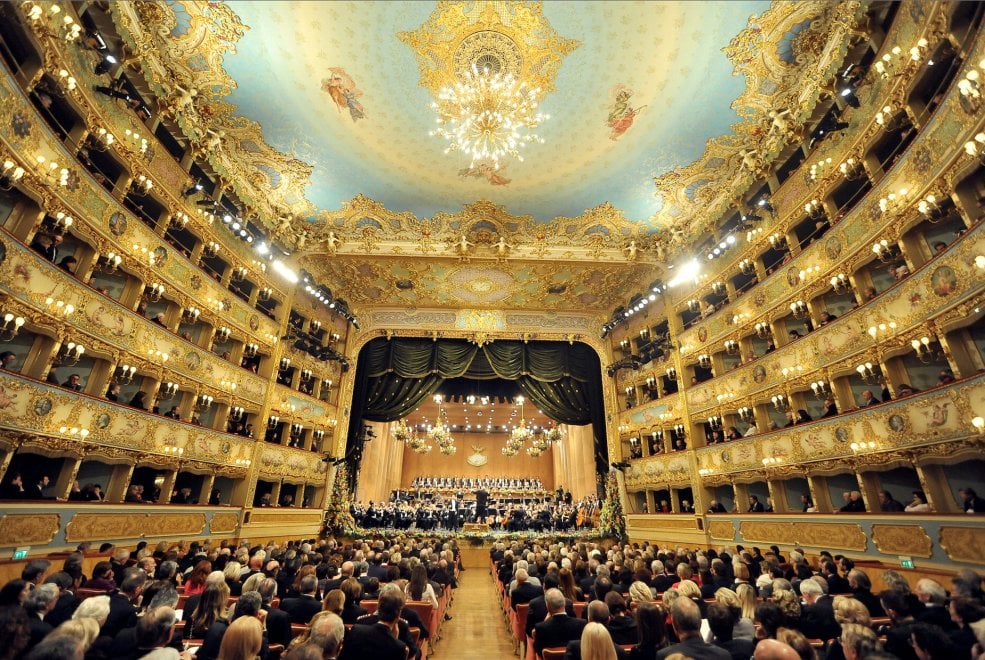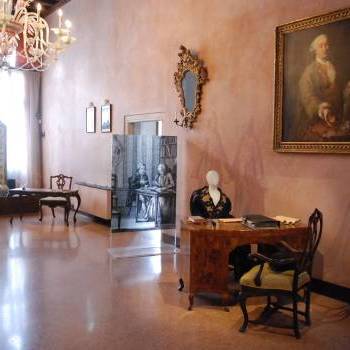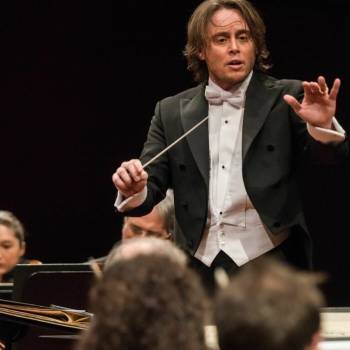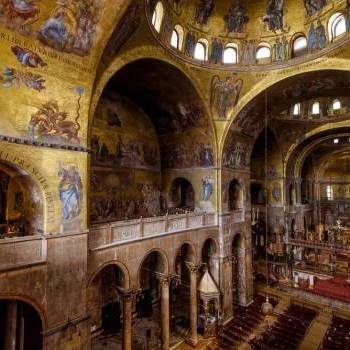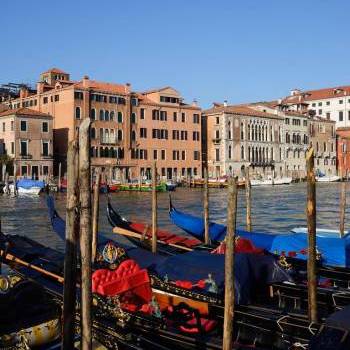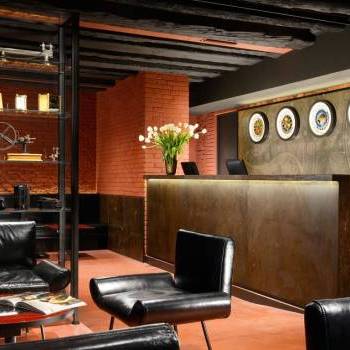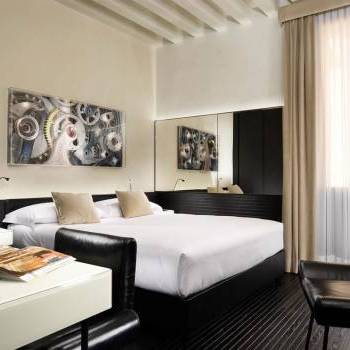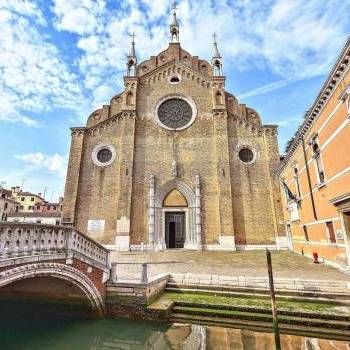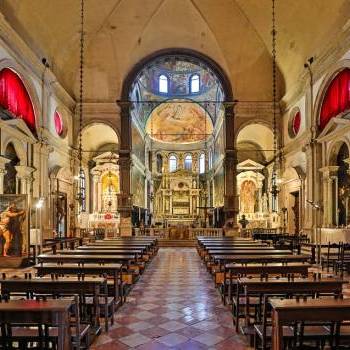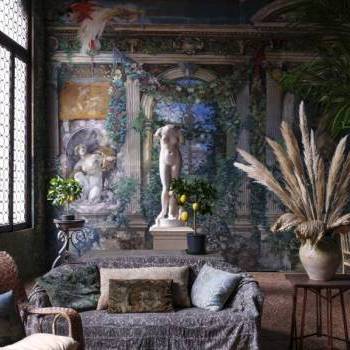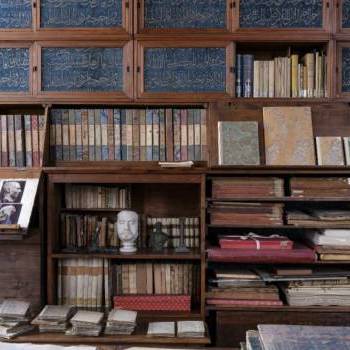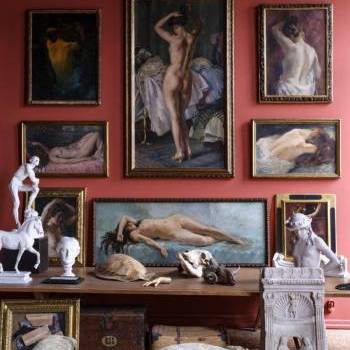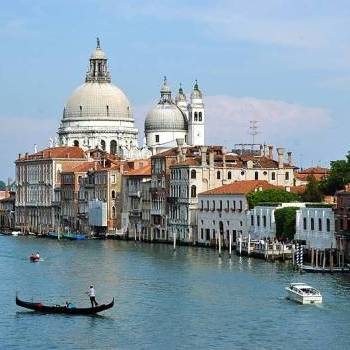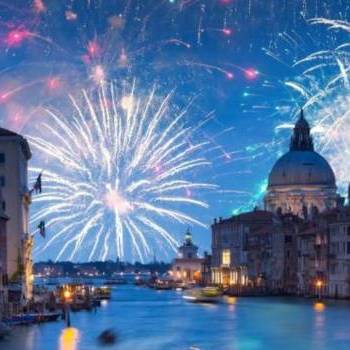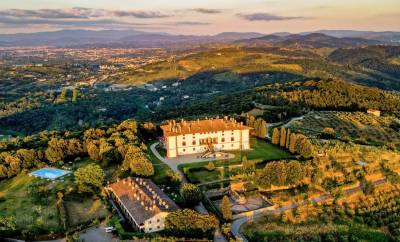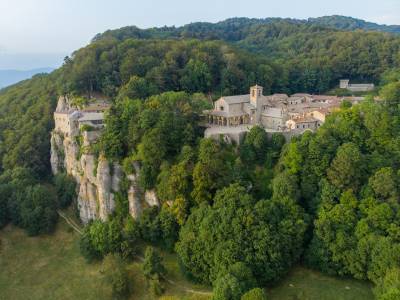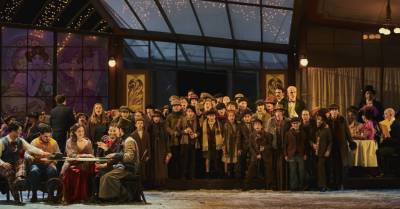
New Year's Eve in Venice, the timeless city
If I had to look for a word to replace “music” I could only think of “Venice”.
(Friedrich Nietzsche)
Venice never dies! Every year it is reborn like a phoenix, celebrating its beauty. This time, an extraordinary night visit to the Basilica of San Marco and, for New Year's Eve, the great concert at the Teatro La Fenice. An itinerary guided by the art historian Dr. Franca Lugato.
Block notes:
- Music and glamour - Attend the end-of-year concert at the Fenice conducted by Michele Mariotti
- Art and Suggestions - Experience the magic of an evening visit to the Basilica of San Marco exclusively for Italia in scena
- Sophisticated Hotel - Experience another hotel from the L’Orologio collection, the hotel chain that plays with the theme of time and that we prefer for our New Year's Eve trips
Day 1 - Monday December 29th 2025 - arrival in Venice
Independent arrival in Venice.
For arrivals at Santa Lucia station between 12:00 and 12:30, a water taxi transfer to the hotel is provided.
Hotel L'Orologio 4* - www.hotelorologiovenezia.com
In a privileged and central position on the Grand Canal, a stone's throw from the Rialto Bridge, it is a 4-star boutique hotel, a small jewel of Venetian hospitality. The theme inspired by the world of collectible watches makes it unique in all of Venice. The structure, completely new, has contemporary and designer furnishings with attention to the smallest details. All the rooms, in a contemporary minimal style, are functional, soundproofed and technological with every kind of comfort. The terrace on the fourth floor and the L'O bar offer the possibility of consuming a quick snack or having a typical Venetian aperitif.
The rooms will be available starting from 2:00 pm.
Le camere saranno disponibili a partire dalle ore 14:00.
3:30 PM: Meet your guide for a visit to Palazzo Fortuny, Mariano Fortuny's house-museum.
Meeting with the guide for a visit to Palazzo Fortuny, casa-museo di Mariano Fortuny.
The opportunity to visit Palazzo Pesaro degli Orfei, (known as Palazzo Fortuny), an ancient late Gothic palace transformed into Mariano Fortuny's house-museum, will be an immersive experience in the world of the eclectic Spanish artist. Paintings, clothes, fabrics, photographs, collector's items recreate the atmosphere of the house-atelier on the first floor, while on the second floor Mariano's skills and experiments in multiple artistic fields are proposed: the behind the scenes of his creations.
The genius of the Spanish artist is exemplified in four focuses: engraving, fabric printing, photography, theater and lighting.
On this floor it is possible to visit Fortuny's studio-library for the first time, a treasure chest full of precious things, everyday objects, curiosities, tools and rare volumes of art and technique.
7.30 pm: Private evening visit "behind closed doors" of the Basilica of San Marco (duration 1 hour).
Dinner on your own and overnight stay at the hotel.
Mariano Fortuny y Madrazo
(Granada 1871 – Venice 1949) Painter, fashion designer, set designer, and photographer, Fortuny came from a refined Spanish family of artists. Orphaned at the age of three, he moved with his mother and sister to Paris, where he came into contact with the artistic, literary, and philosophical world of that art capital. In 1888, the family moved to Venice and continued their exploration of the Old Masters, which had already begun in the Parisian museums. His philosophical readings of Schopenhauer and Nietzsche, as well as his knowledge of Wagner's world, were crucial to the subjects of his early works. In 1899, he took part in the Venice Biennale for the first time and married Henriette Nigrin that same year. He began to develop a fascination with light, which led him to create innovative theatrical lighting systems. In the early years of the century, he worked primarily on theatrical performances, often designing sets and costumes. From 1907, with the help of his wife, a fabric printing workshop was set up in his Venetian palace, and his creations, inspired by the Greek korai tunics, thanks to the silk pleating technique, earned him international fame as an excellent couturier. From the 1920s onwards, he devoted himself more intensely to painting, participating almost continuously in the Biennales from 1922 to 1942.
Day 2 - Tuesday December 30th 2025 – Venice
Breakfast at the hotel.
Morning: Meeting with the guide at the hotel to reach the Chiesa Grande di San Rocco, for the visit. The tour itinerary explores some of the most fascinating aspects of the documentary, iconographic and artistic history of this ancient and prestigious Venetian institution founded way back in 1478 and dedicated to Rocco, a miracle-working saint and protector from the Plague. Particular attention will be paid to the foundation and history of the Scuola, its life during the period of the Serenissima Republic, the events during the foreign dominations and its current function as a museum and place of conservation of an extraordinary historical-artistic heritage.
The itinerary will focus on the visit to the interior of the Scuola Grande where the iconographic and stylistic reading of the paintings will be examined. The rich symbolism linked to San Rocco and the plague, to the Old and New Testaments, will be decoded to provide the right key to reading the entire pictorial cycle.
The tour will allow you to learn in depth about the work and artistic genius of Tintoretto who worked in this building for most of his life.
The visit continues to the Basilica dei Frari.
One of the most important and vital religious and monastic centers of Venice, the Frari complex has its roots in the preaching of the message of simplicity and poverty of Saint Francis of Assisi. The current church was built starting from 1330, thanks to the generosity of some wealthy Venetian families and other benefactors, the current monumental building was consecrated in 1492 and dedicated to the Virgin assumed into heaven: Santa Maria Gloriosa dei Frari. The convent spaces were placed next to the basilica, distributed around two quadrangular cloisters. Entering from the main entrance you are almost magnetically attracted by the most famous work among the masterpieces of the basilica and which dominates unchallenged in the presbytery: the Assumption by Titian. Along the transept there are six apse chapels: treasure chests for the conservation of works of art. In particular the Florentine chapel with the splendid wooden statue of St. John the Baptist by Donatello, the only work of the master in Venice. The extraordinary triptych of the Madonna with Child and Saints by Giovanni Bellini is preserved in the Sacristy. Inside there are various funerary monuments including the Monument to Titian and the Monument to Canova and in the Renaissance altar of the Pesaro family another masterpiece by Titian: the Pala Pesaro. In the Church of the Frari there is – in the so-called Cappella dei Milanesi – the tomb of Claudio Monteverdi, a musician of extreme prestige (he was Maestro di Cappella at San Marco for 30 years), who died in 1643. In contrast to the artist’s greatness, the tomb is surprisingly simple: a modest slab of marble where someone always places a fresh rose!
At the end: Free time for lunch.
Afternoon: Visit Carlo Goldoni's House, where the soul and imagination of the great playwright, one of the first to bring real life to the stage, come to life. A visit to Carlo Goldoni's House will immerse you in the history of theater and the work of an author who authentically and entertainingly portrayed the vibrancy and contradictions of eighteenth-century Venice.
Dinner in selected restaurant and overnight stay in a hotel.
Carlo Goldoni and the 18th-Century Theatrical Revolution
The birthplace of Carlo Goldoni is located in a small Gothic-style building in San Tomà, with a charming courtyard featuring a splendid internal staircase. Thanks to the reconstruction of scenic islands from some of Goldoni's comedies, the rooms on the main floor of the building recreate the theatrical vitality of 18th-century Venice, while also outlining the salient aspects of his poetics and his "revolutionary" approach to interpreting the many facets of real life in his time. In one room, a splendid and priceless 18th-century puppet theater originally housed in the Grimani ai Servi palace in the Cannaregio district. It was common in the 18th century, especially in patrician homes, to perform "chamber theater" using an incredible variety of "wooden actors." The puppets took on a wide variety of roles, with a repertoire that grew ever richer, from melodramas, pantomimes, farces, tragedies, and even delightful ballets. The numerous performances were often staged to entertain illustrious guests, as was the case with the visit of the Elector of Saxony to Ca' Mocenigo in San Samuele in 1714. Puppet theater was the refined version of "piazza theater," where the protagonists were puppets emerging from the "casotti" (houses) with simpler and more popular performances, as can be admired in the paintings of Venetian vedutisti. The rich collection of puppets on display introduces us to the rich and varied miniature world of nobles, servants, harlequins and trousers, knights, Turks, and soldiers, dressed in precious and fashionable costumes. A show that aims to imitate real life and is staged on the original stage of the eighteenth-century theater of Goldoni's house.
Day 3 - Wednesday December 31st 2025 - Venice
Breakfast at the hotel.
Morning: Meet your guide in the hotel lobby and take the vaporetto to Ca' Rezzonico.
Visit Ca' Rezzonico, the museum of 18th-century Venice.
Ca' Rezzonico is one of the most fascinating and richly decorated reconstructions of an 18th-century Venetian aristocratic residence. Thanks to its permanent decorative cycles created by the century's greatest decorators, from Crosato to Tiepolo, from Guarana to Diziani, you'll discover the great era of fresco painting. Furthermore, the wealth of paintings (Canaletto, Longhi, Rosalba Carriera, Guardi, etc.), sculptures (Brustolon, Morlaiter, Le Court), furniture, ornaments, and porcelain will introduce you to the diverse souls of 18th-century Venice. A fitting conclusion to the Age of Enlightenment is the extraordinary pictorial cycle by Giandomenico Tiepolo, detached from Villa Zianigo, which transports us to the "New World."
Free lunch.
4.00 pm: Michele Mariotti conducts the New Year's Concert 2026
Soprano: Rosa Feola
Tenore: Jonathan Tetelman
Choir of the Teatro La Fenice
TEATRO LA FENICE
The New Year's Concert at the Fenice, as per tradition, offers a musical program in two parts: the first exclusively orchestral and the second part dedicated to melodrama, with a series of arias, duets and choral passages performed by soloists of absolute prestige and the Choir of the Teatro La Fenice. Every year the Concert ends with two very famous pages by Giuseppe Verdi, cornerstones of the Italian musical heritage: the Chorus «Va’ pensiero sull’ali dorate» from Nabucco and the festive toast «Libiam ne’ lieti calici» from La Traviata.
8.30 PM: NEW YEAR’S EVE DINNER
At the end of the dinner, we will wait for midnight in Piazza San Marco watching the fireworks to celebrate the new year.
Overnight stay in a hotel.
Day 4 - Monday January 01st '25 – Departure
Breakfast at the hotel and check out by 12:00. Individual departures.
Upon request, it is possible to attend the morning concert at the Teatro La Fenice (as an alternative to the concert on December 31st)
11:15 a.m. concert at the Teatro La Fenice.
PROGRAM NOTES:
- The order of visits may vary for operational needs but without changing the contents.
- The visit itineraries are planned on foot and where necessary by public transport (vaporetto).
- Please report any allergies/intolerances or special dietary needs.
INDIVIDUAL PARTICIPATION PRICES (minimum 10 people)
Double room: €2,290.00
Supplement for single-occupancy double room: €530.00
Supplement for stalls-seat ticket for the concert on January 1, 2026, at 11:00 a.m. – €180.00
THE PRICE INCLUDES:
- 3 nights with breakfast at the 4-star Hotel L'Orologio;
- Transfer by water taxi from Santa Lucia station to the hotel at the indicated time on December 29th;
- Guided tours indicated in the program led by Dr. Franca Lugato, art historian and author of art books;
- Dinner at a selected venue on December 30th;
- Exclusive private evening tour of San Marco on December 29th;
- Stalls seats for the New Year's Eve concert at the Teatro La Fenice on December 31st at 4:00 PM;
- New Year's Eve dinner;
- Entrances and visits to the sites and museums mentioned in the program: Palazzo Fortuny, Scuola Grande di San Rocco, Basilica dei Frari, Casa Goldoni, and Ca' Rezzonico Museum;
- ACTV public transportation tickets (3 days) for vaporettos in Venice;
- On-site assistance;
- Basic medical and baggage insurance.
THE PRICE DOES NOT INCLUDE:
Tourist tax: €4.50 per person per night to be paid locally;
Travel to/from Venice;
Extras, tips, and anything not expressly listed under "The price includes"
The organizer reserves the right to cancel the trip NO LATER THAN 30 days before departure if the minimum number of participants is not reached. In this case, the fee will be refunded in full.
HOW TO BOOK:
The reservation becomes effective upon receipt of:
1. Travel contract, which we will send you at the time of booking
2. Deposit required by bank transfer
DEPOSIT:
A deposit of €800.00 and any travel cancellation insurance premium are required upon booking.
Cancellation insurance can only be purchased at the time of travel registration.
BALANCE:
30 days before departure (by November 29, 2025)
CANCELLATION
In the event of cancellation by the customer, the following penalties will apply, in addition to the insurance fee:
20% of the participation fee for cancellations by October 30, 2025
30% of the participation fee for cancellations by November 29, 2025
50% of the participation fee for cancellations by December 8, 2025
75% of the participation fee for cancellations by December 14, 2025
From December 15, 2025, no refunds will be given in the event of cancellation
Medical and Baggage Insurance included in the package
SUPPLEMENTARY INSURANCE POLICIES
Trip Cancellation Insurance can be purchased at the same time as booking your trip (regulations will be sent upon request).
Amount per person in a double and/or single room
- €42.00 per person up to age 74 (cancellation also possible for pre-existing conditions)
- €84.00 per person from age 75 to 84 (cancellation also possible for pre-existing conditions)
- €142.00 per person from age 85 to 89 (cancellation also possible for pre-existing conditions)
Day 1 - Monday December 29th 2025 - arrival in Venice
Independent arrival in Venice.
For arrivals at Santa Lucia station between 12:00 and 12:30, a water taxi transfer to the hotel is provided.
Hotel L'Orologio 4* - www.hotelorologiovenezia.com
In a privileged and central position on the Grand Canal, a stone's throw from the Rialto Bridge, it is a 4-star boutique hotel, a small jewel of Venetian hospitality. The theme inspired by the world of collectible watches makes it unique in all of Venice. The structure, completely new, has contemporary and designer furnishings with attention to the smallest details. All the rooms, in a contemporary minimal style, are functional, soundproofed and technological with every kind of comfort. The terrace on the fourth floor and the L'O bar offer the possibility of consuming a quick snack or having a typical Venetian aperitif.
The rooms will be available starting from 2:00 pm.
Le camere saranno disponibili a partire dalle ore 14:00.
3:30 PM: Meet your guide for a visit to Palazzo Fortuny, Mariano Fortuny's house-museum.
Meeting with the guide for a visit to Palazzo Fortuny, casa-museo di Mariano Fortuny.
The opportunity to visit Palazzo Pesaro degli Orfei, (known as Palazzo Fortuny), an ancient late Gothic palace transformed into Mariano Fortuny's house-museum, will be an immersive experience in the world of the eclectic Spanish artist. Paintings, clothes, fabrics, photographs, collector's items recreate the atmosphere of the house-atelier on the first floor, while on the second floor Mariano's skills and experiments in multiple artistic fields are proposed: the behind the scenes of his creations.
The genius of the Spanish artist is exemplified in four focuses: engraving, fabric printing, photography, theater and lighting.
On this floor it is possible to visit Fortuny's studio-library for the first time, a treasure chest full of precious things, everyday objects, curiosities, tools and rare volumes of art and technique.
7.30 pm: Private evening visit "behind closed doors" of the Basilica of San Marco (duration 1 hour).
Dinner on your own and overnight stay at the hotel.
Mariano Fortuny y Madrazo
(Granada 1871 – Venice 1949) Painter, fashion designer, set designer, and photographer, Fortuny came from a refined Spanish family of artists. Orphaned at the age of three, he moved with his mother and sister to Paris, where he came into contact with the artistic, literary, and philosophical world of that art capital. In 1888, the family moved to Venice and continued their exploration of the Old Masters, which had already begun in the Parisian museums. His philosophical readings of Schopenhauer and Nietzsche, as well as his knowledge of Wagner's world, were crucial to the subjects of his early works. In 1899, he took part in the Venice Biennale for the first time and married Henriette Nigrin that same year. He began to develop a fascination with light, which led him to create innovative theatrical lighting systems. In the early years of the century, he worked primarily on theatrical performances, often designing sets and costumes. From 1907, with the help of his wife, a fabric printing workshop was set up in his Venetian palace, and his creations, inspired by the Greek korai tunics, thanks to the silk pleating technique, earned him international fame as an excellent couturier. From the 1920s onwards, he devoted himself more intensely to painting, participating almost continuously in the Biennales from 1922 to 1942.
Day 2 - Tuesday December 30th 2025 – Venice
Breakfast at the hotel.
Morning: Meeting with the guide at the hotel to reach the Chiesa Grande di San Rocco, for the visit. The tour itinerary explores some of the most fascinating aspects of the documentary, iconographic and artistic history of this ancient and prestigious Venetian institution founded way back in 1478 and dedicated to Rocco, a miracle-working saint and protector from the Plague. Particular attention will be paid to the foundation and history of the Scuola, its life during the period of the Serenissima Republic, the events during the foreign dominations and its current function as a museum and place of conservation of an extraordinary historical-artistic heritage.
The itinerary will focus on the visit to the interior of the Scuola Grande where the iconographic and stylistic reading of the paintings will be examined. The rich symbolism linked to San Rocco and the plague, to the Old and New Testaments, will be decoded to provide the right key to reading the entire pictorial cycle.
The tour will allow you to learn in depth about the work and artistic genius of Tintoretto who worked in this building for most of his life.
The visit continues to the Basilica dei Frari.
One of the most important and vital religious and monastic centers of Venice, the Frari complex has its roots in the preaching of the message of simplicity and poverty of Saint Francis of Assisi. The current church was built starting from 1330, thanks to the generosity of some wealthy Venetian families and other benefactors, the current monumental building was consecrated in 1492 and dedicated to the Virgin assumed into heaven: Santa Maria Gloriosa dei Frari. The convent spaces were placed next to the basilica, distributed around two quadrangular cloisters. Entering from the main entrance you are almost magnetically attracted by the most famous work among the masterpieces of the basilica and which dominates unchallenged in the presbytery: the Assumption by Titian. Along the transept there are six apse chapels: treasure chests for the conservation of works of art. In particular the Florentine chapel with the splendid wooden statue of St. John the Baptist by Donatello, the only work of the master in Venice. The extraordinary triptych of the Madonna with Child and Saints by Giovanni Bellini is preserved in the Sacristy. Inside there are various funerary monuments including the Monument to Titian and the Monument to Canova and in the Renaissance altar of the Pesaro family another masterpiece by Titian: the Pala Pesaro. In the Church of the Frari there is – in the so-called Cappella dei Milanesi – the tomb of Claudio Monteverdi, a musician of extreme prestige (he was Maestro di Cappella at San Marco for 30 years), who died in 1643. In contrast to the artist’s greatness, the tomb is surprisingly simple: a modest slab of marble where someone always places a fresh rose!
At the end: Free time for lunch.
Afternoon: Visit Carlo Goldoni's House, where the soul and imagination of the great playwright, one of the first to bring real life to the stage, come to life. A visit to Carlo Goldoni's House will immerse you in the history of theater and the work of an author who authentically and entertainingly portrayed the vibrancy and contradictions of eighteenth-century Venice.
Dinner in selected restaurant and overnight stay in a hotel.
Carlo Goldoni and the 18th-Century Theatrical Revolution
The birthplace of Carlo Goldoni is located in a small Gothic-style building in San Tomà, with a charming courtyard featuring a splendid internal staircase. Thanks to the reconstruction of scenic islands from some of Goldoni's comedies, the rooms on the main floor of the building recreate the theatrical vitality of 18th-century Venice, while also outlining the salient aspects of his poetics and his "revolutionary" approach to interpreting the many facets of real life in his time. In one room, a splendid and priceless 18th-century puppet theater originally housed in the Grimani ai Servi palace in the Cannaregio district. It was common in the 18th century, especially in patrician homes, to perform "chamber theater" using an incredible variety of "wooden actors." The puppets took on a wide variety of roles, with a repertoire that grew ever richer, from melodramas, pantomimes, farces, tragedies, and even delightful ballets. The numerous performances were often staged to entertain illustrious guests, as was the case with the visit of the Elector of Saxony to Ca' Mocenigo in San Samuele in 1714. Puppet theater was the refined version of "piazza theater," where the protagonists were puppets emerging from the "casotti" (houses) with simpler and more popular performances, as can be admired in the paintings of Venetian vedutisti. The rich collection of puppets on display introduces us to the rich and varied miniature world of nobles, servants, harlequins and trousers, knights, Turks, and soldiers, dressed in precious and fashionable costumes. A show that aims to imitate real life and is staged on the original stage of the eighteenth-century theater of Goldoni's house.
Day 3 - Wednesday December 31st 2025 - Venice
Breakfast at the hotel.
Morning: Meet your guide in the hotel lobby and take the vaporetto to Ca' Rezzonico.
Visit Ca' Rezzonico, the museum of 18th-century Venice.
Ca' Rezzonico is one of the most fascinating and richly decorated reconstructions of an 18th-century Venetian aristocratic residence. Thanks to its permanent decorative cycles created by the century's greatest decorators, from Crosato to Tiepolo, from Guarana to Diziani, you'll discover the great era of fresco painting. Furthermore, the wealth of paintings (Canaletto, Longhi, Rosalba Carriera, Guardi, etc.), sculptures (Brustolon, Morlaiter, Le Court), furniture, ornaments, and porcelain will introduce you to the diverse souls of 18th-century Venice. A fitting conclusion to the Age of Enlightenment is the extraordinary pictorial cycle by Giandomenico Tiepolo, detached from Villa Zianigo, which transports us to the "New World."
Free lunch.
4.00 pm: Michele Mariotti conducts the New Year's Concert 2026
Soprano: Rosa Feola
Tenore: Jonathan Tetelman
Choir of the Teatro La Fenice
TEATRO LA FENICE
The New Year's Concert at the Fenice, as per tradition, offers a musical program in two parts: the first exclusively orchestral and the second part dedicated to melodrama, with a series of arias, duets and choral passages performed by soloists of absolute prestige and the Choir of the Teatro La Fenice. Every year the Concert ends with two very famous pages by Giuseppe Verdi, cornerstones of the Italian musical heritage: the Chorus «Va’ pensiero sull’ali dorate» from Nabucco and the festive toast «Libiam ne’ lieti calici» from La Traviata.
8.30 PM: NEW YEAR’S EVE DINNER
At the end of the dinner, we will wait for midnight in Piazza San Marco watching the fireworks to celebrate the new year.
Overnight stay in a hotel.
Day 4 - Monday January 01st '25 – Departure
Breakfast at the hotel and check out by 12:00. Individual departures.
Upon request, it is possible to attend the morning concert at the Teatro La Fenice (as an alternative to the concert on December 31st)
11:15 a.m. concert at the Teatro La Fenice.
PROGRAM NOTES:
- The order of visits may vary for operational needs but without changing the contents.
- The visit itineraries are planned on foot and where necessary by public transport (vaporetto).
- Please report any allergies/intolerances or special dietary needs.
INDIVIDUAL PARTICIPATION PRICES (minimum 10 people)
Double room: €2,290.00
Supplement for single-occupancy double room: €530.00
Supplement for stalls-seat ticket for the concert on January 1, 2026, at 11:00 a.m. – €180.00
THE PRICE INCLUDES:
- 3 nights with breakfast at the 4-star Hotel L'Orologio;
- Transfer by water taxi from Santa Lucia station to the hotel at the indicated time on December 29th;
- Guided tours indicated in the program led by Dr. Franca Lugato, art historian and author of art books;
- Dinner at a selected venue on December 30th;
- Exclusive private evening tour of San Marco on December 29th;
- Stalls seats for the New Year's Eve concert at the Teatro La Fenice on December 31st at 4:00 PM;
- New Year's Eve dinner;
- Entrances and visits to the sites and museums mentioned in the program: Palazzo Fortuny, Scuola Grande di San Rocco, Basilica dei Frari, Casa Goldoni, and Ca' Rezzonico Museum;
- ACTV public transportation tickets (3 days) for vaporettos in Venice;
- On-site assistance;
- Basic medical and baggage insurance.
THE PRICE DOES NOT INCLUDE:
Tourist tax: €4.50 per person per night to be paid locally;
Travel to/from Venice;
Extras, tips, and anything not expressly listed under "The price includes"
The organizer reserves the right to cancel the trip NO LATER THAN 30 days before departure if the minimum number of participants is not reached. In this case, the fee will be refunded in full.
HOW TO BOOK:
The reservation becomes effective upon receipt of:
1. Travel contract, which we will send you at the time of booking
2. Deposit required by bank transfer
DEPOSIT:
A deposit of €800.00 and any travel cancellation insurance premium are required upon booking.
Cancellation insurance can only be purchased at the time of travel registration.
BALANCE:
30 days before departure (by November 29, 2025)
CANCELLATION
In the event of cancellation by the customer, the following penalties will apply, in addition to the insurance fee:
20% of the participation fee for cancellations by October 30, 2025
30% of the participation fee for cancellations by November 29, 2025
50% of the participation fee for cancellations by December 8, 2025
75% of the participation fee for cancellations by December 14, 2025
From December 15, 2025, no refunds will be given in the event of cancellation
Medical and Baggage Insurance included in the package
SUPPLEMENTARY INSURANCE POLICIES
Trip Cancellation Insurance can be purchased at the same time as booking your trip (regulations will be sent upon request).
Amount per person in a double and/or single room
- €42.00 per person up to age 74 (cancellation also possible for pre-existing conditions)
- €84.00 per person from age 75 to 84 (cancellation also possible for pre-existing conditions)
- €142.00 per person from age 85 to 89 (cancellation also possible for pre-existing conditions)
